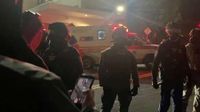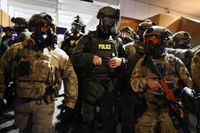On the evening of October 5, 2025, an incident outside the U.S. Immigration and Customs Enforcement (ICE) facility in southern Portland, Oregon, sparked outrage and renewed scrutiny of federal immigration enforcement tactics. What began as a routine medical response to an injured protester quickly escalated into a tense standoff, with federal agents allegedly blocking, threatening, and delaying emergency medical personnel trying to transport a patient to the hospital. The episode, detailed in public dispatch records and confirmed by multiple internal reports from ambulance workers, has become a flashpoint in the broader debate over the conduct of federal officers during protests and the rights of both demonstrators and first responders.
According to Willamette Week, the incident unfolded after protests outside the ICE facility had been simmering for hours. Demonstrators, protesting federal immigration policies, had clashed verbally with agents, with officers deploying pepper balls and gas after a beverage was thrown into the street. Amid this chaos, a protester suffered a broken or dislocated collarbone, prompting a call for medical assistance. American Medical Response (AMR) employees arrived around 9:20 p.m. and quickly loaded the injured individual into their ambulance. Public records confirm that the patient was a 32-year-old protester, and, notably, neither federal agents nor Portland police arrested anyone matching that description on the night in question.
What happened next has been described in detail by the medics involved and corroborated by dispatch logs. The ambulance driver and a crew member recounted that, after loading the patient, they were prevented from leaving the ICE facility by federal agents. The agents insisted on riding in the ambulance to the hospital, a request the medics refused because the protester was not under arrest and the agents lacked proper paperwork. As the driver reported in an internal incident statement, "I repeated again that no officer is permitted to ride in the ambulance and that they can meet us at the hospital and that we needed to be let out of the facility. Officers then began walking away from me whenever I spoke."
The situation grew increasingly fraught as a group of 5-8 men in civilian clothes, none displaying identification, entered the garage and silently blocked the ambulance's path. At the same time, according to dispatch records cited by Common Dreams, a crowd of 50-60 federal agents assembled, completely obstructing the road out. The medics, feeling trapped, attempted to deescalate the situation. The crew member in the passenger seat exited the vehicle to speak with the officers, while the driver, after flipping on the emergency lights, slowly inched the ambulance forward in hopes of being allowed to leave.
But as the ambulance inched toward the garage exit, a man described as being in civilian clothes and wearing a neck wrap stepped in front of the vehicle, ordering the driver to stop. The driver put the ambulance in park, causing it to lurch forward slightly—a movement that was evidently misinterpreted by one of the nearby agents. The driver described what happened next in stark terms: "I looked up and suddenly the entire group of officers… were crowded around the open car door, some of them leaning forward towards me, inches from my face."
It was at this moment that the confrontation reached its peak. The driver recalled, "An agent pointed his finger at me in a threatening manner and began viciously yelling in my face, stating, 'DON'T YOU EVER DO THAT AGAIN, I WILL SHOOT YOU, I WILL ARREST YOU RIGHT NOW.'" The driver, still in shock, later wrote, "They were not only accusing me of such a thing, but crowding and cornering me in the seat, pointing and screaming at me, threatening to shoot and arrest me, and not allowing the ambulance to leave the scene. This was no longer a safe scene, and in that moment, I realized that the scene had not actually been safe the entire time that they were blocking us from exiting, and that we were essentially trapped."
The standoff lasted for more than 20 minutes, with the ambulance crew reporting a sense of being "essentially trapped" and unsafe. Only after the prolonged delay were they finally permitted to leave, with an unmarked vehicle following them to the hospital. At the hospital, several men in civilian dress exited the trailing vehicle and entered the building. The AMR spokesperson, Ashton Polk, later stated that the company was "reviewing the specifics of the situation" and was "committed to a thorough review." Meanwhile, Austin DePaolo, spokesperson for Teamsters 223, the union representing the ambulance crew, said, "Our members responded with professionalism and calm in a situation that could have easily gotten out of control. We respect the work law enforcement officers do every day, and we expect that same respect and cooperation when our members in EMS are performing their duty to protect and save lives," as reported by The Oregonian.
The Department of Homeland Security did not immediately respond to requests for comment from multiple media outlets. The incident has drawn attention not only for its immediate drama but also as part of a larger pattern of aggressive federal enforcement tactics in Portland and other U.S. cities. Over the same weekend, peaceful demonstrators and journalists were reportedly targeted with pepper spray, flash-bang grenades, and rubber bullets without clear provocation. Viral videos and eyewitness accounts from across the country depict similar confrontations: in Maryland, an officer was seen pointing a gun at onlookers after a scuffle; in Colorado, agents smashed a car window with a baton as a baby sat in the back seat; and in Chicago, agents fired pepper spray at a pastor speaking outside a detention facility.
The Trump administration has defended its deployment of federal agents in cities like Portland, often characterizing protests as violent provocations or even "organized terrorist attacks" on federal property, according to statements from White House officials cited by Common Dreams. Critics, however, argue that the administration's approach has only heightened tensions. Fred Tsao, senior policy counsel at the Illinois Coalition for Immigrant and Refugee Rights, told NPR, "This administration, overall, seems more interested in heightening the tensions instead of trying to ramp them down."
For Portland, the October 5 incident is just the latest in a string of confrontations between demonstrators, federal agents, and local authorities. The ICE facility has been the site of persistent protests, with the federal response often criticized as heavy-handed. On the night of the ambulance standoff, the situation was further complicated by legal wrangling over the deployment of National Guard troops, with a federal judge issuing orders to prevent their use in the city.
As investigations continue and calls for accountability mount, the events of that night remain a vivid reminder of the challenges facing both first responders and those exercising their rights to protest. The medics’ ordeal, now documented in multiple internal and public reports, has become a touchstone for those concerned about the intersection of law enforcement power, civil liberties, and the essential work of emergency medical services. Whether this incident will prompt changes in federal tactics or inspire new protocols for protecting medical workers in tense situations remains to be seen, but for many in Portland and beyond, the memory of that night—and the threats that echoed through the ambulance doors—won’t soon be forgotten.


